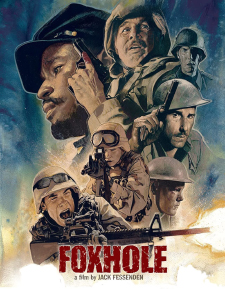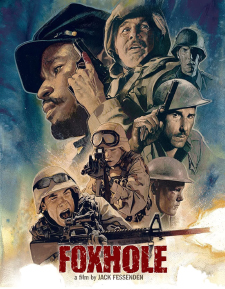Foxhole (Blu-ray Review)

Director
Jack FessendenRelease Date(s)
2021 (March 28, 2023)Studio(s)
Glass Eye Pix/Nous Entertainment (Yellow Veil Pictures)- Film/Program Grade: B-
- Video Grade: A
- Audio Grade: B+
- Extras Grade: A
Review
Foxhole focuses on five same-named American characters in wars from three different centuries—The Civil War, World War I, and the war in Iraq. Tracing similarities that hold true for all wars and dealing with how soldiers balance fear, tedium, and duty to survive, the film explores human strengths and shortcomings.
Bookended by overhead views of dead soldiers, the film immediately establishes the tragedy of war. Each of the three stories is a self-contained drama with the enemy mostly alluded to but rarely seen.
In the Civil War episode, black soldier Jackson (Motell Gyn Foster) is wounded in vicious hand-to-hand combat with a Confederate soldier (Asa Spurlock). Jackson makes his way through a mist-covered battlefield to fellow Union soldiers Conrad (Angus O’Brien), Morton (Alex Hunt), Clark (Cody Kostro) and Wilson (James LeGros), who are digging a foxhole. Evaluating whether they should continue following their orders to dig the foxhole or take the wounded Jackson to medics five miles away, they debate issues of racism, self-preservation, and responsibility to the many over the individual.
The World War I episode, shot in black-and-white, finds a German soldier dropping into the American soldiers’ foxhole, where the debate becomes whether to kill him or regard him as a fellow human being running from death on the battlefield. Jackson opts for preserving the German’s life, while his fellow soldiers, having the power of life or death over another person, philosophically but often rashly, consider the choice they must make.
The final episode, set in Iraq, finds the group of Americans stranded in a Humvee disabled by an IED. Since this is the modern army, the group also has a female member, Gale (Andy Matichak). Jackson is now the leader, confident and keeping his calm under enormous pressure as they are sitting ducks separated from their convoy, with enemy combatants nearby.
Despite a small budget, director Jack Fessenden serves up impressive production values and Collin Brazie’s cinematography adds significantly to atmosphere, providing each of the episodes with a distinctive look that suggests the era portrayed. Transitions blending one segment into the next are done with mist or clouds of dust. After the Iraq sequence, the scene shifts briefly to show post-war vignettes with a bit of elegiac narration.
Foxhole offers excellent ensemble acting. Using the same actors for each episode allows us to see how their characters remain consistent or change with the times. The ultimate statement that director Fessenden is making is that war draws disparate individuals together in extraordinary circumstances, forcing them to get along with each other in order to survive, make tough decisions, and recognize the value of human life.
Foxhole was captured by director of photography Collin Brazie digitally with Arri Alexa Mini and Elite Anamorphic Primes cameras for the Civil War segment; Cooke Anamorphic Primes cameras for the World War I segment; and Zeiss Ultra Primes cameras for the Iraq segment. Parts 1 and 3 are in color. Part 2 is in stark black-and-white. The film is presented in the widescreen aspect ratio of 1.39:1. Part 1 uses a great deal of artificial fog to simulate a gloomy battlefield, which also blurs the background so we can’t see the tent that encloses the set. The color palette in Part 1 is dull. Even the blue Union uniforms look dull. The black-and-white photography in Part 2 is strikingly crisp and clear, particularly in contrast with the hazy look of Part 1. Digital tracer bullets whiz by soldiers as they crawl through a no-man’s-land of scorched earth and barbed wire. In Part 3, set almost entirely in a Humvee, lighting suggests a burning desert sun and a frigid, eerily quiet night. With the soldiers stuck in the desert wearing heavy military gear, it’s unconvincing that they don’t show much sweat on their faces.
The soundtrack is English 5.1 DTS-HD Master Audio. English SDH subtitles are an available option. Dialogue is clear and distinct through all three episodes. Sound effects include machine gun fire in Parts 2 and 3. The absence of ambient sound is unsettling, likely intended by the director to create a surrealistic feel. The quiet builds suspense and is a marked contrast to the loud battle sounds typical of other war pictures. The score consists primarily of percussion, which provides an insistent, driving rhythm and enhances suspense.
Bonus materials include the following:
- Introduction by Jack Fessenden (:47)
- Audio Commentary with Jack Fessenden
- Documentary (90:03)
- Animation Diary (12:36)
- No Jockin’ by Darquell Music Video (3:01)
- All for One Short Film (:52)
- Q&A from New York Premiere at MOMA (12:28)
Introduction – Director Jack Fessenden refers to Foxhole as a labor of love for all those involved in its production. In addition to directing, Fessenden wrote the screenplay, co-produced, and wrote the score.
In his commentary, Fessenden discusses how the sets were envisioned and constructed by his crew. The foxhole, used for both the Civil War and World War I episodes, was under a huge tent in order to control fog effects. He mentions different camera lenses and why they were used in particular shots. Steadicam was used in a number of sequences. Balancing the limited color palette in Part 1 was a major challenge. The actors had minimal rehearsal time because of a tight schedule. A week was devoted to shooting each of the three war episodes. Fassenden speaks about how he attempted to sync the percussionist soundtrack to the rhythms of action on screen. He refers to this as his homage to Stanley Kubrick’s Paths of Glory. The Iraq episode was filmed in a California desert. The Humvee never actually moved but was shaken by crew members to simulate motion. Actual Iraq veterans provided input regarding technical info and personal stories. The armorer instructed actors in the use of weapons. A great deal of improvisation was involved in the Iraq episode. Fessenden wanted each episode to contain quieter, character-driven moments.
Documentary – Producer Larry Fessenden (Jack Fessenden’s father) discusses raising money to finance the filming of Foxhole and selecting locations, costumes, and props. Excerpts from audition tapes are shown. Jack Fessenden started planning the film while he was still in school. Actors are interviewed and provide anecdotes about their experiences making the movie. Behind-the-scenes footage shows the crew preparing the foxhole set and choreographing a fight. Storyboards served as a visual blueprint for the film. The post-production process is shown, with actors dubbing lines and music added.
Animation Diary – In sped-up motion with a musical track, the preparation, filming, and post-production of Foxhole are shown in telescoped time.
No Jockin’ Music Video – Performed by Darquell, this song was written for the film.
All for One – Introduced by Jack Fessenden, this brief film is about friendship, a theme that he points out is in all of his films.
Q&A at MOMA – After a screening at New York City’s Museum of Modern Art, Jack Fessenden answers questions about making of the film, including its inspiration, writing process, casting, problems during filming, and reception by audiences.
Booklet – The enclosed 20-page booklet contains a detailed description of the film from its opening through its three different war episodes. Also included are still photos and a behind-the-scenes photo of Jack Fessenden and crew working on the set.
Though Foxhole is an ambitious film with a worthwhile theme, the use of the same actors in all three segments is more theatrical than cinematic. Fessenden manages to hold the viewer’s attention with constantly changing camera angles and by infusing the film with a good deal of suspense, but the movie’s budgetary limitations undermine it with the practically invisible enemy. We hear about them, and the soldiers convey fear, yet the fear never translates into something tangible. Fessenden’s dialogue is reminiscent of vintage war movies with its stock characters—the old-timer, the bigot, the leader, the philosopher. What’s missing is the joker, which might have lightened the mood somewhat. As it stands, Foxhole is a noble experiment that never completely works.
- Dennis Seuling

